- Generative Engine Optimization (GEO) optimizes content to be cited and surfaced by generative AI systems like ChatGPT and Perplexity.
- Effective GEO demands semantic depth, factual clarity, structured data, and off-site authority to improve AI-driven visibility.
- GEO marks a shift from ranking in search to becoming part of AI-generated answers, reshaping digital discovery and marketing strategy.
If you’ve been paying attention to how people are discovering content online lately, then you already know we’re not just living in the era of search engines anymore we’ve entered the age of answer engines. Whether it’s ChatGPT, Claude, Gemini, or Perplexity, generative AI systems are rapidly becoming the go-to destination for users seeking answers, not just links.
That shift has huge implications for those of us working in content strategy, SEO, digital publishing, or brand visibility. Traditional SEO, the kind that’s been honed over two decades, is no longer sufficient. That’s why I and many others have started to think and work in terms of Generative Engine Optimization, or GEO.
What follows is a practitioner’s field guide to GEO. It’s informed by original research, experimentation, case studies, and early lessons from those already navigating this new terrain. I’m writing this for peers who care about both strategy and technical depth and want to stay ahead of what’s coming next.
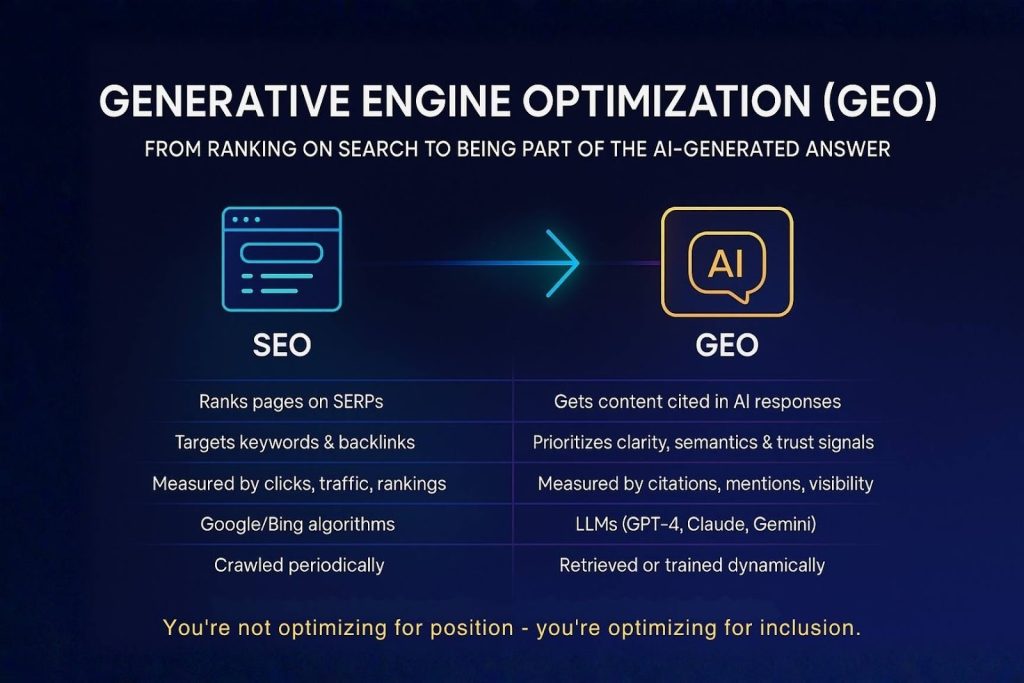
What is Generative Engine Optimization (GEO)?
A Working Definition
Generative Engine Optimization is the practice of optimizing your content so it can be discovered, cited, or surfaced by generative AI models in their synthesized responses to user queries.
In contrast to traditional SEO which helps your pages rank higher in search results, GEO is about becoming part of the answer itself. You’re not fighting for a position on page one. You’re fighting to be included in the paragraph that the AI writes.
How GEO Differs From SEO
There are several fundamental differences between SEO and GEO. Let’s break them down:
| SEO | GEO |
| Optimizes for search engine ranking positions (SERPs) | Optimizes for inclusion in generative AI outputs |
| Prioritizes keyword targeting and backlinks | Prioritizes semantic breadth, factual clarity, and machine readability |
| Measured via impressions, clicks, rankings | Harder to measure focuses on mentions, citations, and downstream traffic from AI interfaces |
| Google/Bing algorithm driven | LLM-driven (e.g., GPT-4, Claude, Gemini), using fine-tuned or retrieval-augmented models |
| Crawled/indexed periodically | Used in training data or real-time retrieval systems |
| Subject to frequent ranking algorithm updates | Influenced by opaque model behaviors and retraining cycles |
SEO isn’t going away. But GEO is not a feature of SEO, it’s a parallel paradigm. It demands its own playbook, its own metrics, and its own strategic mindset.
Why GEO Matters Now
The Context: Generative AI Has Changed the Discovery Funnel
When someone asks ChatGPT for “the best CRM for early-stage startups,” they don’t get a list of ten links. They get a direct answer, often with a few product names and sometimes a short rationale. They might not even realize that the answer is synthesized from dozens, possibly hundreds of sources.
Here’s the catch: only a few brands or pages make it into that answer. If yours isn’t one of them, your visibility drops to zero for that interaction. That’s a stark change from traditional search, where even being third or fifth in the SERP meant you had a shot at a click.
Let’s put some numbers on this shift:
- ChatGPT usage exploded to hundreds of millions of users within its first year.
- Perplexity reported 780 million search queries in May 2025 (CEO statement), and third-party traffic tracking shows ~194M site visits in September 2025.
- Gartner predicts traditional search engine volume will drop 25% by 2026, with share shifting to AI chatbots and other virtual agents.
These are not experiments anymore. These are new user habits forming in real time.
User Behavior is Now Conversational
One of the defining features of this shift is the rise of conversational and multi-intent queries. In search, a user might type:
“best CRM early-stage startups”
In ChatGPT, the same user might say:
“I just started a SaaS company and need a lightweight CRM. I don’t want Salesforce. Anything that’s good for a small team and integrates with Gmail?”
That kind of query isn’t just longer, it’s layered with nuance. Generative engines are designed to understand that nuance and deliver holistic, personalized answers, a clear evolution in how AI is reshaping digital content discovery, particularly when you examine how artificial intelligence continues to redefine traditional search behaviors. But the answer will only be as good as the content behind it.
If you haven’t optimized your content to be easily synthesized by a model, you’re invisible in this interaction.
The Emergence of AI-First Discovery Channels
Let’s talk about the platforms that are defining this landscape:
- ChatGPT with browsing enabled: Answers in real-time, sometimes citing live pages.
- Google SGE (Search Generative Experience): Merges generative summaries with traditional results, showing sources inline.
- Perplexity.ai: A search engine that’s entirely citation-first and conversational.
- Bing Chat: AI-assisted search with contextual answers and footnoted links.
Each of these has its own quirks, but they share one common principle: users stay in the interface longer and interact directly with the content AI presents, not with raw search results.
That’s where GEO comes in. If you’re not being cited or incorporated into that synthesized content, you’re out of the loop.
Key Strategies for Generative Engine Optimization
Now that we’ve clarified what GEO is and why it matters, let’s shift gears and get into what actually works. Below are the strategic pillars that, in my experience and research, make the biggest difference in whether your content shows up in generative responses.
These aren’t surface-level tips. Each one reflects the deeper mechanics of how large language models (LLMs) retrieve, rank, and reassemble information into human-readable answers.
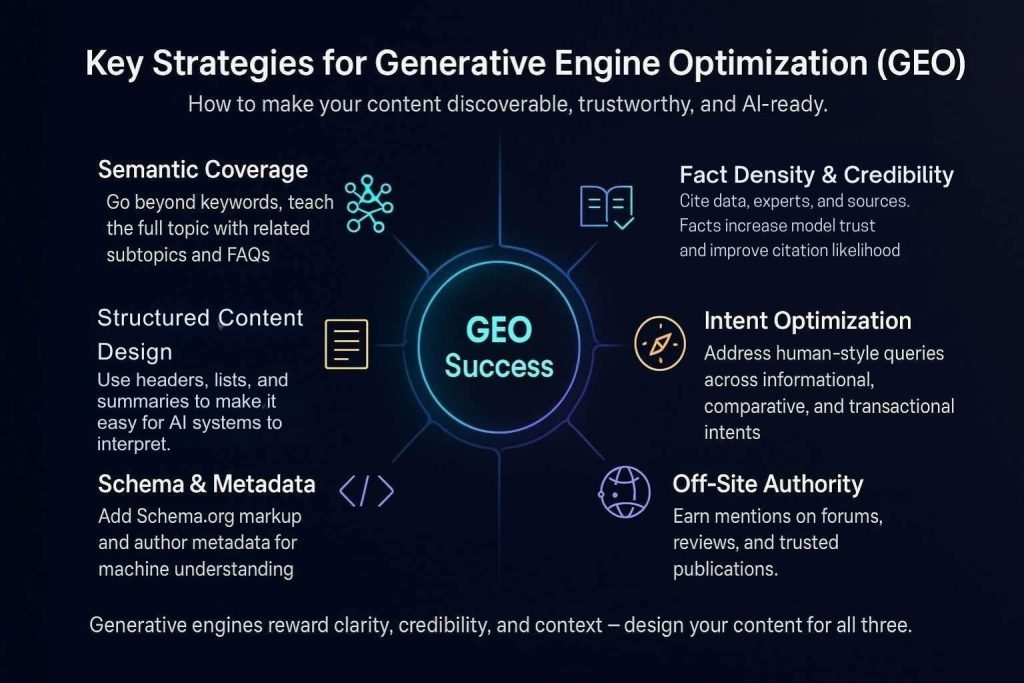
Semantic Coverage: Don’t Just Rank Teach
The most effective GEO content is expansive. It doesn’t just target keywords it teaches a topic in context.
Generative engines excel at answering layered questions, but they need raw material. The more semantically rich your content is meaning, the more related subtopics and entities it covers the more useful it is to the model.
What that looks like in practice:
- Break down a concept into subtopics and create in-depth content for each.
- Use clear, contextual language. Not just “CRM,” but also “customer relationship software,” “sales pipelines,” “email integrations,” and “contact management tools.”
- Build out FAQ sections that reflect real queries users pose in AI interfaces.
A useful trick: take your core content and run it through an AI (e.g., “What questions might someone ask based on this article?”). Then, answer those questions directly on your page.
The goal is to make your content so informative that the model chooses it not just to reference, but to explain from.
Fact Density and Source-Centric Writing
LLMs don’t think in opinions. They pattern-match factual statements. That’s why content filled with specific, cited facts performs better in AI outputs than vague prose, especially when aligned with the trust and clarity signals machines are increasingly trained to recognize.
What to include:
- Verified statistics with citations
- Quotes from recognized experts
- Dates, figures, comparisons
- Links to authoritative references (even if external)
In my testing, the inclusion of real-world data increases the likelihood of citation in tools like Perplexity or Bing Chat by a significant margin. These engines often render factual responses verbatim, and your fact might be the one that gets lifted.
Don’t just say “This method improves retention.” Say, “This onboarding method increased user retention by [number]%, according to [source].”
Also, don’t be afraid to link out. That used to feel like giving away link equity, but in GEO, it signals credibility and AIs pick up on that.
Structure Matters: Think Like a Prompt Engineer
Generative engines look for structured, digestible content. You need to write in a way that’s easy for a model to scan, chunk, and synthesize.
What I do:
- Use H2 and H3 headers that match common question formats
- Write in short paragraphs, ideally 2–4 sentences
- Include bullet lists, tables, and summaries where appropriate
- Lead sections with concise definitions or takeaways
- Repeat the question verbatim before answering it (yes, like FAQ format)
Think of it like prompt-engineering your own content: the better you “train” the model to understand your structure, the more likely it is to pull from it cleanly and clearly.
A 2,000-word wall of text with no headers or subheadings? Might as well be invisible.
Schema Markup and Structured Data
This is where traditional SEO meets GEO.
Structured data via Schema.org markup helps machines understand what your content means, not just what it says.
Here’s what I recommend implementing on any page you want to perform well in generative answers:
- FAQPage schema for FAQs
- HowTo schema for tutorials or walkthroughs
- Article or BlogPosting schema for editorial content
- Product, Review, or Service schemas for commercial pages
I also strongly encourage including author metadata (using Person or Organization schema) with clear affiliations, social proof, and areas of expertise. This isn’t just good practice, it builds authoritativeness signals that AI can incorporate into its response logic.
The clearer you are about what your content is and who it’s from, the better chance you have of being surfaced as a trusted source.
Off-Site Mentions and External Authority
Here’s something that many people miss: Generative models don’t just read your website. They incorporate knowledge from everywhere your brand is mentioned online especially if those mentions come from community forums, review platforms, or well-linked publications.
If your product or content is being talked about on:
- Stack Overflow
- Twitter/X threads
- Product Hunt
- Quora
- Medium
- GitHub (for dev tools)
…then that content might make it into an AI’s training corpus or retrieval index.
This is why GEO isn’t just about on-page optimization. It’s about ensuring your brand’s footprint extends across the web, especially into sources that generative models frequently crawl and trust.
I’ve seen this play out directly. One of our clients started getting picked up in ChatGPT answers for a “best developer tools” prompt and it turned out the answer was based on discussions from Reddit and Hacker News, not their website.
The lesson: get your name in the conversation, wherever it’s happening.
Optimize for Intent Across the Funnel
Just like in SEO, you have to think about query intent but the queries themselves are more human now. They’re not “best CRM startup” they’re “I’m building a startup and need a CRM that integrates with Gmail and doesn’t cost much.”
I bucket intent like this:
- Informational: “What is X?”, “How does X work?”
- Comparative: “X vs Y?”, “What are alternatives to X?”
- Transactional: “Where can I buy X?”, “Is there a free trial?”
- Navigational: “OpenAI login”, “Trello pricing”
You need content that answers all of these and ideally, answers them in plain English, not marketing speak.
And yes, that means embracing long-tail queries. Some of the highest-performing GEO content is built around specific, niche queries the ones people are most likely to ask in a conversational prompt.
Tools, Technologies, and Platforms Supporting GEO
Let’s be clear: this field is still emerging. That means our toolkit is evolving, and in many cases, we’re adapting SEO infrastructure to meet the needs of GEO. But there are several categories of tools and approaches that are already proving useful.
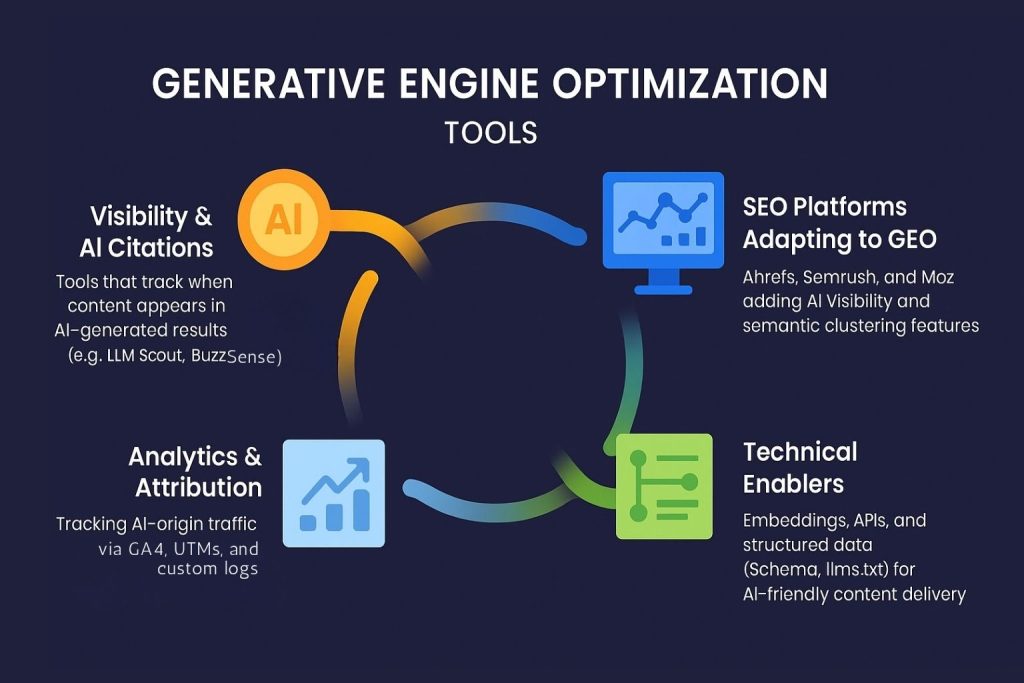
Tools for Visibility Monitoring and AI Citations
The most immediate challenge in GEO is visibility: how do you know if your content is being cited or used in AI-generated responses?
A few tools are starting to fill that gap:
- LLM Scout: Tracks whether your brand or content appears in generative responses across platforms like ChatGPT, Bing Chat, and Perplexity. Early-stage, but promising.
- BuzzSense / WhiteBox: Tools in development aimed at helping marketers audit their content’s visibility inside AI results. They’re designed more for brand monitoring than SEO metrics.
- HubSpot AI Search Grader: A free tool that scores your content’s readiness for generative search, giving recommendations based on AI-friendliness.
These tools are rudimentary compared to traditional SEO platforms, but we’re starting to see integrations with the big players.
Traditional SEO Platforms Adding GEO Features
Platforms like Semrush, Ahrefs, Moz, and Surfer SEO are beginning to layer in support for GEO. Some new features include:
- “AI snapshot visibility” indicators (i.e., whether your content shows up in Google SGE boxes).
- Topic clustering optimized for semantic search and LLM ingestion.
- SERP overlays that indicate if an AI summary is present, and whether you’re included in the cited sources.
These additions are still in beta in many tools, but they’re a step toward unifying SEO and GEO under one analytics umbrella.
Analytics and Attribution
Once users start finding you via generative interfaces, the next challenge is attribution. You need to understand what traffic came via an AI-generated answer not just from traditional links.
Ways I’ve handled this include:
- Segmenting Perplexity.ai and Bing Chat traffic using referral URLs in GA4 or Adobe Analytics.
- Tagging links in AI answers (if you can influence the anchor format) with UTM parameters to distinguish that clickstream.
- Using server-side logs to track unusual user agents or click patterns originating from AI tools.
It’s far from perfect. Most generative AI responses don’t drive traffic unless they include a link and even when they do, attribution can get lost. But for now, I treat any trackable referral from an AI tool as a high-value, qualified visitor.
Technical Enablers: Embeddings, Structured Data, and API Hooks
If you’re working at an enterprise or developer level, there are more technical strategies you can pursue:
- Embeddings and vectorized content: LLMs often rely on semantic similarity to retrieve answers, a behavior increasingly shaped by core developments in machine learning and retrieval models. Structuring your knowledge base so it’s indexable as embeddings (e.g., via OpenAI’s API or a vector DB like Pinecone) allows you to integrate with RAG (retrieval-augmented generation) pipelines.
- Providing structured feeds or APIs: If your content updates frequently (e.g., product prices, availability, news), offering a JSON or XML API lets partners including AI companies pull fresh data without hallucinating.
- llms.txt (experimental): Inspired by robots.txt, some webmasters are testing llms.txt to guide AI crawlers on what to ingest. Adoption is limited right now most LLMs ignore it but it may become a de facto standard in the future.
In short: think like a data provider, not just a publisher. The easier you make it for an AI to ingest and structure your content, the better your odds of being included in its output.
Case Studies: GEO in the Real World
Let’s move from theory into practice. One of the most compelling GEO success stories comes from a small but fast-growing SaaS brand: Tally.

Tally’s Playbook: 25% Growth via ChatGPT
According to Tally’s co-founder, 25% of new signups in late April–early May 2025 were facilitated by ChatGPT citations. That’s not a typo; one quarter of their acquisition was directly tied to generative answers.
How did they pull it off?
1. Content Alignment With Queries
They created detailed, intent-matched pages for key queries like:
Each page was written in a comparison format that directly aligned with the type of answers users expect in AI summaries. This meant Tally was often included as a named recommendation sometimes even with clickable links.
2. Community-Driven Mentions on Reddit
Tally didn’t just focus on their site. They went to where LLMs learn: Reddit.
They encouraged their users to talk about Tally in relevant subreddits (r/SaaS, r/NoCode, r/Entrepreneur). These discussions ended up being part of the LLM training corpus and surfaced in ChatGPT’s and Perplexity’s recommendations.
Remember, Reddit is heavily cited in generative answers, especially for subjective or community-driven queries.
3. Iterative Refinement Based on AI Output
Here’s where it gets smart.
Tally’s team regularly queried ChatGPT and Perplexity with relevant prompts, tracked how often they were mentioned, and adjusted their content accordingly.
For example, if ChatGPT listed competitors but skipped Tally, they’d update their page to address the missing angle (e.g., better pricing breakdown, clearer feature parity).
Over time, this feedback loop led to better rankings inside AI-generated answers.
Lessons from Tally
The Tally case proves several key principles of GEO:
- You don’t need to be the biggest, you need to be the most relevant and well-structured.
- Community presence matters as much as your own domain.
- GEO is not set-and-forget it’s a living process of refinement based on observation.
If you’re building in a niche with high commercial intent, these strategies can be copied, adapted, and scaled.
Ethical and Regulatory Considerations in Generative Engine Optimization
If you’re thinking about GEO seriously, you can’t ignore the ethical minefield we’re operating in. The same systems we’re optimizing for are still unregulated, poorly understood by the public, and often lack transparency about how they use content.
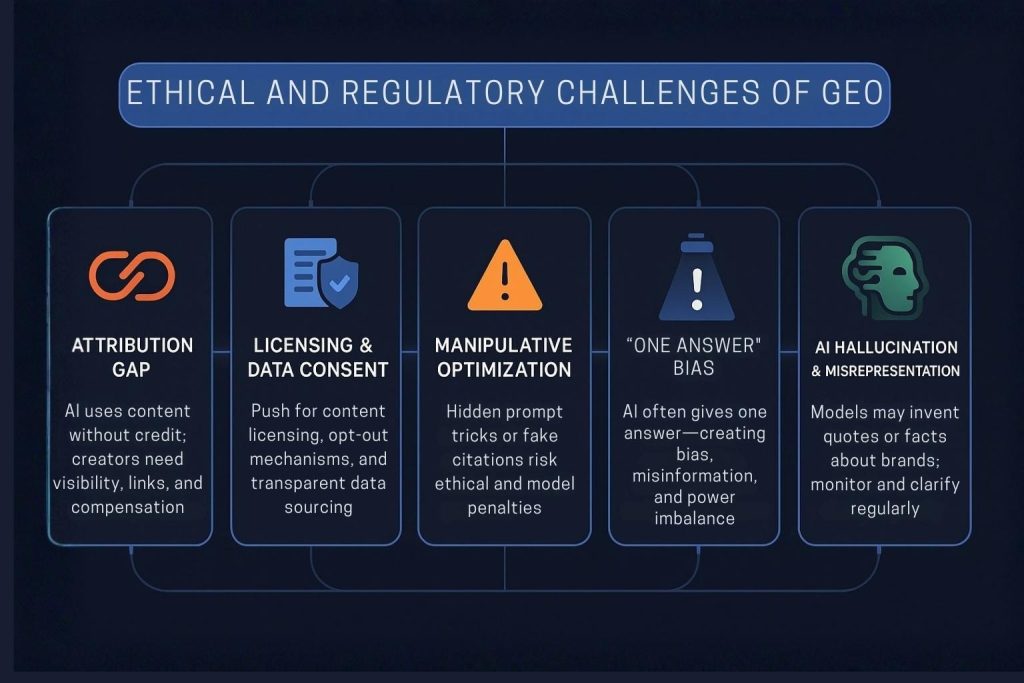
Let’s talk about what we, as professionals, need to consider when crafting strategies that intersect with these powerful models.
The Problem of Attribution
One of the most frequent complaints I hear from publishers and creators is this:
“My content shows up in AI-generated answers, but I don’t get any traffic or credit.”
This is especially common with tools like ChatGPT or Claude, where citations are either absent or optional.
This isn’t just a technical issue. It’s a moral one.
If our work is powering someone else’s product especially one that could divert search traffic away from our sites we deserve:
- Clear attribution
- A link back to the source
- Ideally, some form of usage control or compensation
Without this, GEO runs the risk of being a zero-sum game: we help AIs sound smarter, and in return, they cannibalize our audiences. Some platforms (like Perplexity or Bing Chat) do better by showing footnotes and links. Others do not.
This lack of standardization is unsustainable and it’s starting to draw legal attention.
Licensing, Data Consent, and Content Control
There’s a looming battle over the content that powers these generative models.
Models like GPT-4, Claude, and Gemini were trained (at least in part) on scraped web content often without explicit permission from publishers. Now, as they generate responses using that content, there’s a growing call for:
- Licensing frameworks to compensate content creators
- Opt-out mechanisms like robots.txt or Google-Extended
- Data provenance standards to trace how information flows into answers
Some publishers have already taken legal action. Others, like the Associated Press, have struck licensing deals with OpenAI to allow controlled usage of their archives.
As a practitioner, you need to be aware of these shifts. They could shape what kind of content remains visible in generative engines and under what conditions. For example, if Google decides it can only cite sources that explicitly opt-in via Google-Extended, that’s a huge filter on what gets seen.
I also recommend staying informed on your local regulations. The EU, through the AI Act and the Digital Services Act, is already laying down rules that could influence AI disclosures and data sourcing. Expect more to come.
Manipulative Practices and Prompt Injection
Let’s talk about the dark side of GEO: manipulation.
Because generative models are susceptible to subtle prompt injections and textual cues, some have started experimenting with hidden optimization techniques. These include:
- Injecting adversarial phrases into text to bias LLM outputs
- Using authoritative tone or fake citations to appear more trustworthy
- Spinning facts or using language designed to get picked up by model heuristics
I’ve seen tests where a seemingly benign piece of text is written to act like a stealth prompt. The result? A chatbot like ChatGPT suddenly recommends a specific product not because it’s the best, but because the content planted the seed.
This crosses a line. And if enough people abuse these tactics, it won’t be long before model developers start blacklisting or penalizing sites they detect as manipulative.
We’ve seen this before. In the early days of SEO, black hat link schemes worked until Google cracked down. The same will happen here.
If you’re playing the long game, stick to white-hat GEO. Build real authority. Let your content stand on its own merit. And if you do experiment, document it, disclose it, and don’t use those results to mislead users.
The “One Answer” Dilemma
There’s another ethical wrinkle here and it’s a big one:
Generative engines increasingly provide a single answer, which users tend to trust as the answer.
This dynamic raises the stakes. If an AI gives only one recommended therapy, one investment suggestion, one product then being the content behind that answer carries enormous weight.
It also raises serious risks:
- What if that answer is wrong?
- What if it’s biased toward whoever optimized most aggressively?
- What if the AI subtly amplifies misinformation or consensus fallacies?
As strategists and content creators, we have a responsibility not to game that system blindly. Just because we can get our brand into an answer doesn’t mean we should, especially if doing so would mislead the user or marginalize better sources.
Generative systems will need to improve at showing multiple perspectives, especially for subjective or controversial questions. But until then, it’s up to us to approach GEO with integrity.
AI Hallucination and Brand Misrepresentation
Another GEO-related challenge is hallucination. That’s when an AI invents a quote, a fact, or even an entire narrative and attributes it to your brand.
This is dangerous for two reasons:
- It puts your reputation at risk you may be quoted saying things you never said.
- You can’t always control it hallucinations can occur even if your brand wasn’t part of the training data.
I recommend actively monitoring generative platforms for how they reference you. Ask ChatGPT, Perplexity, or Gemini about your product or organization. You might be surprised what comes back.
If hallucinations are common, it’s a signal to improve your content clarity and authority. Provide definitive answers on your own domain, publish clear product specs, and correct misinformation in the wild (e.g., forums, Q&A threads).
That’s not just good brand hygiene. It’s GEO insurance, and a reminder of the growing need for ethical alignment with AI systems.
The Future of GEO: What Comes Next and How to Stay Ahead
GEO isn’t a passing trend. It’s the early phase of a long-term shift in how content gets surfaced, cited, and consumed across digital platforms. While the field is still forming, I think we can already see the outline of what’s ahead.
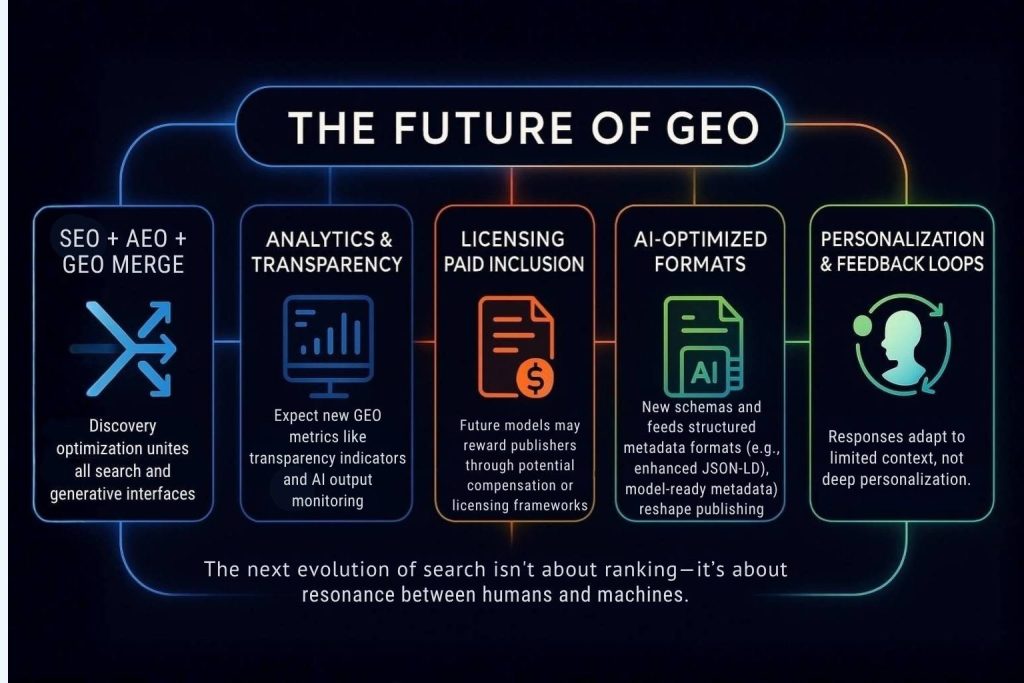
Here are the most important trends, emerging challenges, and strategic bets I believe we need to be making right now.
The Convergence of SEO, AEO, and GEO
Search Engine Optimization, Answer Engine Optimization (for tools like Alexa and Siri), and Generative Engine Optimization are quickly blending into a single practice: discovery optimization.
What’s changing isn’t just the tools; it’s the entire landscape of how people find answers.
We’re already seeing the shift:
- Google SGE blends AI-generated content with traditional SERPs.
- Bing Chat lets you toggle between chat, search, and comparison.
- Platforms like Perplexity or You.com are creating entirely new search paradigms.
In this future, your content isn’t being evaluated in isolation, it’s being cross-validated, summarized, and synthesized by a multi-layered system. You can’t afford to think in silos anymore.
Better Webmaster and Analytics Integration (Eventually)
One of the major missing pieces in GEO today is feedback. We don’t yet have a “Search Console” for ChatGPT or Gemini.
But that’s going to change. Expect to see:
- SGE performance data added to Google Search Console.
- New AI discovery metrics in analytics tools (time-to-first-response, citation velocity, etc.).
- Partnership dashboards from model providers showing which of your pages were used or cited.
This kind of transparency is inevitable and when it arrives, it will be a game-changer. You’ll be able to tie AI visibility directly to content, campaigns, and business outcomes. Start preparing your team now to build around that data layer.
Paid Inclusion and Content Licensing Models
Let’s talk about the business side of this. Right now, AI companies ingest content for free often without licensing it and generate monetizable outputs.
That model won’t scale ethically or economically.
Expect to see:
- Micropayment models for content usage (similar to music streaming royalties).
- Premium inclusion programs for trusted, structured content providers.
- AI syndication networks that aggregate and license quality data to model developers.
If you’re a publisher or content network, you’ll need to think about whether to opt-in or opt-out of these systems and whether you want to negotiate individually or collectively.
The biggest risk? Getting left out. Once platforms formalize “trusted source” lists, you’ll want to be on them.
AI-Optimized Content Formats
There’s a technical frontier opening up here, and it’s going to affect content workflows directly.
We’re already seeing signs of:
- AI-ready content schemas
- Model-friendly metadata (beyond Schema.org)
- Dedicated feeds for LLM ingestion (think ai_feed.xml)
- Companion plain-text or JSON layers for each article
Just like we built mobile-first websites in the early 2010s, we’ll start building AI-first content frameworks in the 2020s. And just like mobile reshaped UX, AI will reshape how we structure, package, and distribute knowledge.
I’d keep an eye on CMS plugins, publishing tools, and DAM systems that start to support this natively. This is where operational leverage will come from.
Algorithmic Shifts in LLM Behavior
One of the wild cards in GEO is the model update cycle. Unlike Google’s core updates which are public, documented, and relatively slow, LLMs can be updated in stealth and push changes overnight.
That includes:
- New sourcing priorities (favoring fresher data, or downranking commercial domains)
- Enhanced hallucination filtering
- Source deduplication models that consolidate similar sites into one canonical reference
This is going to make GEO feel more volatile than SEO ever was. It’s critical that we don’t overfit to current behaviors. Instead, build for clarity, completeness, and semantic robustness, so your content continues to perform even as models evolve.
GEO and Personalization
Most LLMs are not heavily personalized yet but that’s going to change fast.
Soon, AI assistants will tailor responses based on:
- Search history
- Personal preferences
- App integrations
- Location, demographics, behavior
That means GEO will split into two tracks:
- Global GEO: Optimizing for generalized, universal answers.
- Personalized GEO: Optimizing for response patterns tied to niche segments, personas, or behaviors.
If you’re in e-commerce, education, health, or SaaS, this could become a strategic advantage. Think about how your content could show up differently for different users. Then build with that spectrum in mind.
Closing the Loop: AI as Both Searcher and Creator
One final note and this is speculative, but important.
We’re entering a world where:
- Users discover your content via an AI interface
- You use an AI to optimize that content
- Another AI evaluates the output
- A different AI summarizes it for another user
It’s AI all the way down and that creates feedback loops we’ve never dealt with before.
We have to be careful. The more we optimize for models, the more we risk creating derivative, self-reinforcing content. The challenge ahead isn’t just visibility, it’s meaningful contribution.
We’ll need to:
- Keep human perspectives and originality at the center
- Regularly audit for “AI drift” in our content (i.e., overfitting to model preferences)
- Preserve authorship, context, and editorial voice even inside a synthetic ecosystem
In other words, our job as strategists and content professionals is not just to win the game, but to protect the value of the game itself.
Final Takeaways: Navigating the GEO Era
We’re at the beginning of a fundamental transformation in digital content strategy. Just as SEO redefined publishing, GEO will reshape the next generation of content operations, brand strategy, and information access.
To stay ahead, here’s what I recommend:
1. Think Like an AI
Train yourself and your team to understand how LLMs evaluate and assemble content. Prompt them. Study their outputs. Reverse-engineer their logic.
2. Build Structured, Semantic, and Specific Content
Write for synthesis. Organize for scanning. Cite sources. Reduce ambiguity. Be the site an AI can trust to explain something clearly and correctly.
3. Expand Your Digital Footprint
Ensure you’re not just present on your site, but across forums, knowledge bases, media outlets, and citation-heavy platforms. Authority comes from consistency and omnipresence.
4. Measure What You Can, and Watch What You Can’t
Track AI referrals. Use tools that monitor citations. Set up processes to regularly query generative engines and review the results. This is your new version of rank tracking.
5. Optimize, Ethically
Don’t manipulate. Don’t inject hidden prompts. Don’t overpromise. GEO will only work if users trust the answers they get and if model creators trust the sources they use.
If you’re advising clients, leading content teams, or building digital products, I encourage you to take GEO seriously but not cynically. This isn’t about gaming a system. It’s about building a new, durable foundation for content visibility in an AI-native world.
We’re not just optimizing for engines anymore.
We’re optimizing for machines that speak, reason, summarize, and influence.
The opportunity and the responsibility has never been bigger.
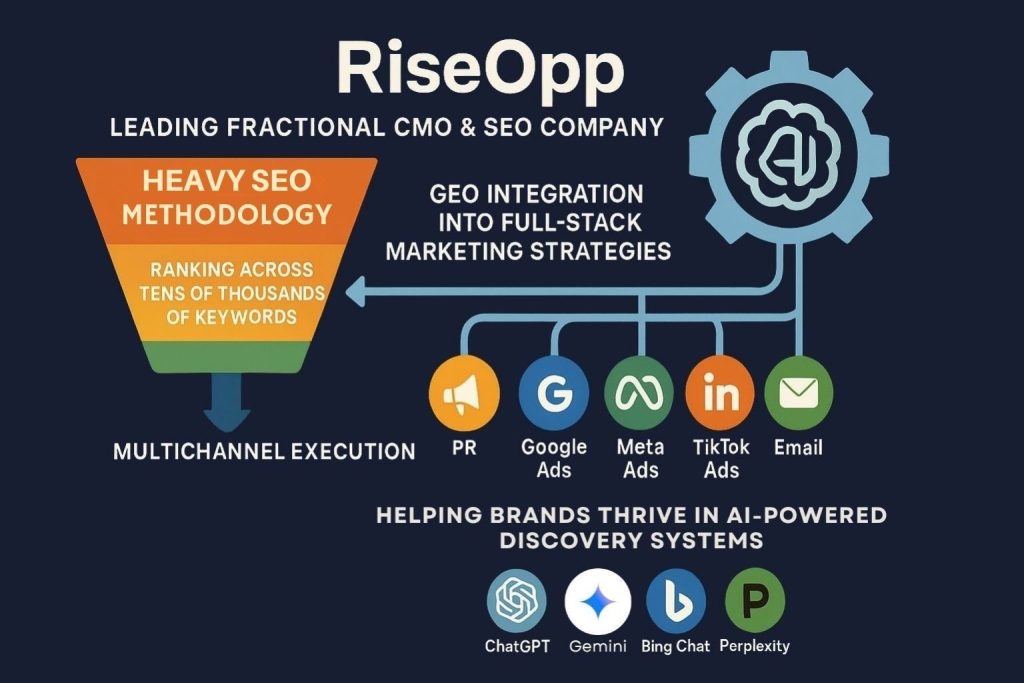
How RiseOpp Helps You Navigate and Win in the GEO Era
At RiseOpp, we’ve spent years helping companies evolve with the digital landscape and the emergence of Generative Engine Optimization is no exception. As a company at the forefront of both strategic marketing and advanced SEO, we see GEO not as a replacement for traditional approaches, but as the next layer in a truly integrated discovery strategy.
We work closely with clients from scrappy startups to enterprise brands to develop content strategies that don’t just rank well in search engines, but also resonate within generative AI platforms. Whether it’s through high-authority content creation, structured semantic design, or proactive monitoring of AI visibility, we’re already helping clients get cited, sourced, and surfaced in the very systems that are changing how people find information.
As part of our broader Fractional CMO Services, we integrate GEO into an AI-driven marketing approach that also includes SEO (anchored in our proprietary Heavy SEO methodology), paid media, PR, brand development, and performance marketing across every major channel from Google and Meta to LinkedIn, TikTok, and affiliate networks.
We understand the mechanics of how AI systems select and synthesize content. And more importantly, we know how to help your brand become a trusted voice in the age of machine-mediated discovery.
Comments are closed